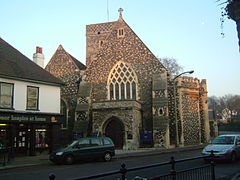Dartford
| Dartford | |
|---|---|
 Holy Trinity Church, Dartford High Street |
|
| Dartford shown within Kent | |
| OS grid reference | TQ538739 |
| • London | 18.8 mi (30.3 km) |
| District | |
| Shire county | |
| Region | |
| Country | England |
| Sovereign state | United Kingdom |
| Post town | DARTFORD |
| Postcode district | DA1, DA2 |
| Dialling code | 01322 |
| Police | Kent |
| Fire | Kent |
| Ambulance | South East Coast |
| EU Parliament | South East England |
| UK Parliament | |
Dartford is the principal town in the Borough of Dartford, Kent, England. The town is situated on the border of Kent and Greater London, bordering the London Borough of Bexley. It also borders the Borough of Thurrock, Essex, via the Dartford Crossing of the River Thames and Gravesham to its east.
The town centre lies in a valley through which the River Darent flows, and where the old road from London to Dover crossed: hence the name, from Darent + ford. Dartford became a market town in medieval times and, although today it is principally a commuter town for Greater London, it has a long history of religious, industrial and cultural importance. It is an important rail hub; the main through-road now by-passes the town itself.
Dartford is twinned with several other towns and cities abroad including Hanau in Germany, Gravelines in France and Namyangju in South Korea.
In prehistoric times, the first people appeared in the Dartford area around 250,000 years ago: a tribe of prehistoric hunter-gatherers whose exemplar is called Swanscombe Man. Many other archaeological investigations have revealed a good picture of occupation of the district with important finds from the Stone Age, the Bronze Age and the Iron Age.
When the Romans engineered the Dover to London road (afterwards named Watling Street), it was necessary to cross the River Darent by ford, giving the settlement its name. Roman villas were built along the Darent Valley, and at Noviomagus (Crayford), close by. The Saxons may have established the first settlement where Dartford now stands. Dartford manor is mentioned in the Domesday Book, compiled in 1086, after the Norman conquest. It was then owned by the king.
...
Wikipedia

